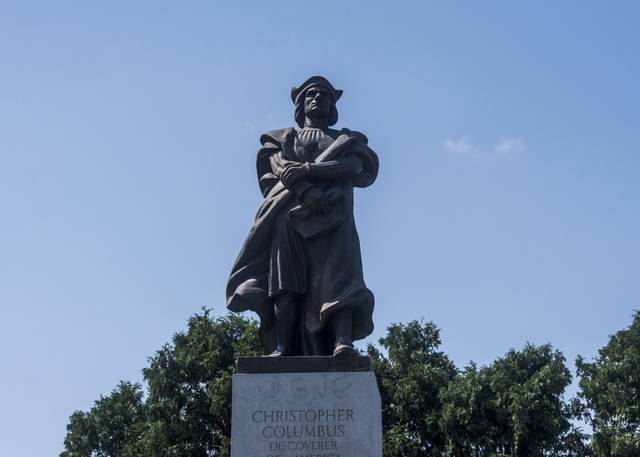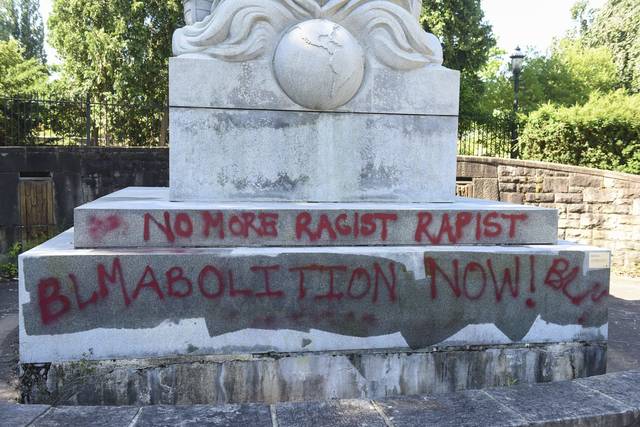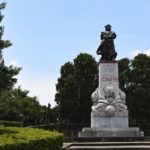The fate of a 62-year-old statue of Christopher Columbus that towers over Schenley Drive near Phipps Conservatory in Oakland will be decided Sept. 23 by the Pittsburgh Art Commission.
Before the commission meets, it is working to gauge public sentiment about the statue, one of Pittsburgh-based Italian artist Frank Vittor’s most visible works. A virtual hearing on the statue is set for 5:30 p.m. Thursday .
More than 14,000 people have signed an online petition, started by Finn Murphy, calling for the removal of the statue.
“Christopher Columbus is far from the heroic explorer too many curriculums believe him to be,” Murphy wrote in the petition.
It calls Columbus “a terrible man that should not be celebrated at all” because of the way native Americans were mistreated after his 1492 trip, which started the European colonization of the Americas.
“He didn’t ‘discover’ America, he found native-inhabited land and claimed it for himself, using extreme violence and cruelty,” Murphy wrote in the petition, which calls for removing the statue and replacing it with a memorial to a Pittsburgher more worthy of the site.
Murphy could not be reached for comment for this story.
The city’s Italian-American population has a different view on the issue, and they’re working to “preserve, protect and promote” Columbus and the statue, according to Guy Costa, 64, of Squirrel Hill.
Costa, who retired last year from a job as the city government’s chief operating officer, is an Italian American who helps organize the annual Columbus Day parade in Bloomfield, which is historically the base of the city’s Italian population.
Many Italian-Americans would like the statue to remain in place, Costa said.
If the city decides to remove the statue, Costa is working with a group of Italian Americans to find a spot on private property where the statue could be relocated.
“We’re going to find a new home for him,” Costa said.
The larger-than-life statue, about 13 feet tall, was created by Vittor, an Italian artist who married a Pittsburgh woman and settled in the city. The effort to create the statue took 49 years and started in 1909, the year of the city’s first Columbus Day parade, according to the Pittsburgh Public Art & Civic Design Division, which oversees the city’s collection of monuments, memorials and public art works.
The statue has been repeatedly vandalized and marked with graffiti, most recently in July, as Columbus’ historical stature has come under attack.
In June, a Columbus statue in Richmond, Va., was torn down by protesters. Another Columbus statue was decapitated in Boston.
Pittsburgh faced a similar outcry in 2017 surrounding Stephen Foster, a Pittsburgh native and pioneer of the American songbook. A Foster statue, first erected in 1900 and in Oakland since 1944, depicted him with a Black man playing banjo at his feet, a posture some deemed racist.
The Foster statue remains in storage in Highland Park after it was removed in 2o18.
The controversies about Columbus hurt the Italian community, which itself has been subjected to racial injustice in America, including an 1891 killing of 11 Italian Americans in New Orleans following the murder of the city’s police chief, according to the Italian Sons and Daughters of America.
The killings were the largest mass lynching in American history and, in response to it, President Benjamin Harrison held a national celebration of Columbus in 1892, the 400th anniversary of Columbus’ first trip to the Americas, the organization said on its website in a post explaining why it opposes removing the statue.
In 1937, Columbus Day became a national holiday. It’s also a day Italians use to celebrate their heritage, the organization’s Western Pennsylvania district vice president Patricia Mocello said.
“Why would we destroy something like that?” Mocello, 72, of Brookline, said of the statue.
It’s an important piece of art in Pittsburgh and is a source of pride for Italians.
“It’s important to us because a lot of our immigrants settled here,” Mocello aid. “We work hard to try to keep our ethnicity in focus.”
The atrocities wrought in part by Columbus aren’t a reason to remove the statue, she said.
“This happened over 500 years ago. We should learn from history. We should learn about the diversity of different people and respect all of that,” Mocello said.















